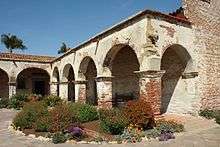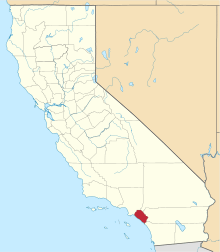San Juan Capistrano, California
| San Juan Capistrano, California | ||
|---|---|---|
| City | ||
  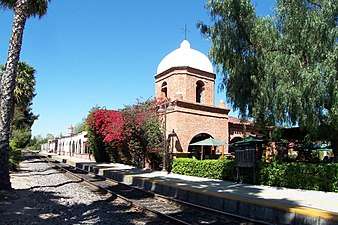 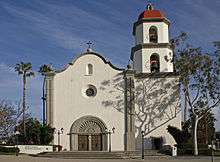 Clockwise from top: Egan House, San Juan Capistrano Depot, Mission Basilica San Juan Capistrano, Trabuco Creek, Mission San Juan Capistrano | ||
| ||
| Motto(s): "Preserving The Past To Enhance The Future" | ||
 Location of San Juan Capistrano within Orange County, California. | ||
 San Juan Capistrano, California Location in the United States | ||
| Coordinates: 33°29′58″N 117°39′42″W / 33.49944°N 117.66167°WCoordinates: 33°29′58″N 117°39′42″W / 33.49944°N 117.66167°W | ||
| Country |
| |
| State |
| |
| County | Orange | |
| Incorporated | April 19, 1961[1] | |
| Named for | Giovanni da Capistrano | |
| Government | ||
| • Type | Council-Manager | |
| • City council[2] |
Mayor Sergio Farias, Mayor Pro Tem Brian L. Maryott, Kerry K. Ferguson, Pam Patterson, and Derek Reeve | |
| • City manager[3] | Benjamin Siegel | |
| Area[4] | ||
| • Total | 14.43 sq mi (37.37 km2) | |
| • Land | 14.23 sq mi (36.87 km2) | |
| • Water | 0.20 sq mi (0.51 km2) 1.26% | |
| Elevation[5] | 121 ft (37 m) | |
| Population (2010)[6] | ||
| • Total | 34,593 | |
| • Estimate (2016)[7] | 36,276 | |
| • Density | 2,548.37/sq mi (983.94/km2) | |
| Time zone | UTC-8 (Pacific) | |
| • Summer (DST) | UTC-7 (PDT) | |
| ZIP code | 92675 | |
| Area code | 949 | |
| FIPS code | 06-68028 | |
| GNIS feature IDs | 1661383, 2411793 | |
| Website | sanjuancapistrano.org | |
San Juan Capistrano (/sæn
History
San Juan Capistrano is the site of a Catholic mission for which it is named, Mission San Juan Capistrano. When the Mission was founded in 1776, the region was populated by the Acjachemen band of Native Americans, called Juaneños by the Spanish. The mission was named after Giovanni da Capistrano (1386–1456), the Franciscan saint from Capestrano, in the Italian region of Abruzzo.
Giovanni da Capistrano, although raised to the sainthood by the Roman Catholic Church is documented by historical research by the Oxford University historian Norman Davies to have burnt to death more than 50 Jews in May 1453 in the Polish city of Wroclaw.[8]
The city is the site of California's oldest residential neighborhood, Los Rios. It is also the home of the oldest in use building in California, the Serra Chapel in the Mission. The area was the site of both the first vineyard and first winery in California .
In the 1830s, Richard Henry Dana Jr., author of the classic Two Years Before the Mast visited the area as a sailor engaged in the hide trade on board the ship Pilgrim. Describing the locale, which then included what is now the neighboring city of Dana Point, he gushed, "San Juan is the only romantic spot in California." The area was also the locale of Johnston McCulley's first Zorro novella, The Curse of Capistrano, published in 1919 (later renamed The Mark of Zorro after the success of the film of the same name).
The city is featured in a map entitled "Inferno" in Valve's Counter-Strike series.
The city's first mayor was Carl Buchheim.[9]
Demographics
| Historical population | |||
|---|---|---|---|
| Census | Pop. | %± | |
| 1880 | 376 | — | |
| 1960 | 1,120 | — | |
| 1970 | 3,781 | 237.6% | |
| 1980 | 18,959 | 401.4% | |
| 1990 | 26,183 | 38.1% | |
| 2000 | 33,826 | 29.2% | |
| 2010 | 34,593 | 2.3% | |
| Est. 2016 | 36,276 | [7] | 4.9% |
| U.S. Decennial Census[10] | |||
2010
The 2010 United States Census[11] reported that San Juan Capistrano had a population of 34,593. The population density was 2,419.9 people per square mile (934.3/km2). The racial makeup of San Juan Capistrano was 26,664 (77.1%) White (55.8% Non-Hispanic White),[12] 193 (0.6%) African American, 286 (0.8%) Native American, 975 (2.8%) Asian, 33 (0.1%) Pacific Islander, 5,234 (15.1%) from other races, and 1,208 (3.5%) from two or more races. Hispanic or Latino of any race were 13,388 persons (38.7%).
The Census reported that 34,506 people (99.7% of the population) lived in households, and 87 (0.3%) lived in non-institutionalized group quarters.
There were 11,394 households, out of which 4,030 (35.4%) had children under the age of 18 living in them, 6,706 (58.9%) were opposite-sex married couples living together, 1,089 (9.6%) had a female householder with no husband present, 526 (4.6%) had a male householder with no wife present. There were 456 (4.0%) unmarried opposite-sex partnerships, and 87 (0.8%) same-sex married couples or partnerships. 2,381 households (20.9%) were made up of individuals and 1,407 (12.3%) had someone living alone who was 65 years of age or older. The average household size was 3.03. There were 8,321 families (73.0% of all households); the average family size was 3.44.
The population was spread out with 8,518 people (24.6%) under the age of 18, 3,066 people (8.9%) aged 18 to 24, 7,804 people (22.6%) aged 25 to 44, 9,792 people (28.3%) aged 45 to 64, and 5,413 people (15.6%) who were 65 years of age or older. The median age was 40.2 years. For every 100 females, there were 98.3 males. For every 100 females age 18 and over, there were 96.7 males.
There were 11,940 housing units at an average density of 835.2 per square mile (322.5/km2), of which 8,462 (74.3%) were owner-occupied, and 2,932 (25.7%) were occupied by renters. The homeowner vacancy rate was 1.3%; the rental vacancy rate was 4.7%. 24,052 people (69.5% of the population) lived in owner-occupied housing units and 10,454 people (30.2%) lived in rental housing units.
According to the 2010 United States Census, San Juan Capistrano had a median household income of $75,356, with 12.7% of the population living below the federal poverty line.[12]
2000
As of the census of 2000, there were 33,826 people, 10,930 households, and 8,196 families residing in the city. The population density was 2,381.2 inhabitants per square mile (919.1/km2). There were 11,320 housing units at an average density of 307.6 persons/km2 (796.9 persons/mi2). The racial makeup of the city was 78.47% White, 0.78% African American, 1.07% Native American, 1.92% Asian, 0.11% Pacific Islander, 14.21% from other races, and 3.43% from two or more races. 33.13% of the population were Hispanic or Latino of any race.
Of the 10,930 households, 39.9% had children under the age of 18 living with them, 62.7% were married couples living together, 8.5% had a female householder with no husband present, and 25.0% were non-families. 19.7% of all households were made up of individuals and 10.3% had someone living alone who was 65 years of age or older. The average household size was 3.06 and the average family size was 3.45.
In the city, the population was spread out with 28.1% under the age of 18, 7.8% from 18 to 24, 27.3% from 25 to 44, 23.7% from 45 to 64, and 13.1% who were 65 years of age or older. The median age was 36 years. For every 100 females, there were 96.9 males. For every 100 females age 18 and over, there were 94.0 males.
The median income for a household in the city was $62,392, and the median income for a family was $69,481. Males had a median income of $47,574 versus $34,821 for females. The per capita income for the city was $29,926. About 10.7% of the population and 6.6% of families were below the poverty line, including 14.8% of those under age 18 and 4.2% of those age 65 or over.[13][14]
Government
As of 2018, the City Council members are: Sergio Farias (Mayor), Brian Maryott (Mayor Pro Tem), Kerry K. Ferguson, Pam Patterson, and Derek Reeve.[15] The current city manager is Benjamin Siegel.[3]
In the California State Legislature, San Juan Capistrano is in the 36th Senate District, represented by Republican Patricia Bates, and in the 73rd Assembly District, represented by Republican Bill Brough.[16]
In the United States House of Representatives, San Juan Capistrano is in California's 49th congressional district, represented by Republican Darrell Issa.[17]
Geography
San Juan Capistrano is located in south Orange County and is bisected by Interstate 5. 33°29′58″N 117°39′42″W / 33.49944°N 117.66167°W (33.499493, -117.661614).[18]
According to the United States Census Bureau, the city has a total area of 14.3 square miles (37 km2). 14.1 square miles (37 km2) of it is land and 0.1 square miles (0.26 km2) of it (1.26%) is water.
Economy

Top employers
According to the City's 2015 Comprehensive Annual Financial Report,[19] the top employers in the city are:
| # | Employer | # of employees |
|---|---|---|
| 1 | St. Margaret's Episcopal School | 429 |
| 2 | Costco | 294 |
| 3 | 24 Hour Fitness | 266 |
| 4 | Emeritus at San Juan Capistrano | 159 |
| 5 | JSerra Catholic High School | 145 |
| 6 | Color Spot Nurseries | 135 |
| 7 | Fluidmaster | 130 |
| 8 | Marbella Country Club | 106 |
| 9 | Capistrano Connections Academy | 100 |
| 10 | San Juan Hills Golf Club | 95 |
The Capistrano Unified School District (CUSD) Office is located within the city limits, and employs approximately 4,000 people. However, as most of these employees are located at individual school sites, and are indirectly employed under the Orange County Department of Education, CUSD is not included in this listing.
The Cliff Swallows of Capistrano
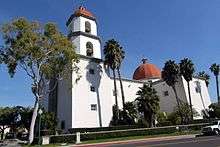
San Juan Capistrano is also known for its cliff swallows. The protected birds return during migration, which originates in the town of Goya, Argentina, around St. Joseph's Day (March 19) each year. The day is celebrated by the city's annual Swallows' Day Parade and other festive events.[20] The swallows leave around October 23, the former feast day of St. John of Capistrano. The 1940 hit song "When the Swallows Come Back to Capistrano", written by Leon René, is a love song inspired by this annual event.
From 2009 to 2017, the famous swallows did not return to San Juan Capistrano.[21] They instead began migrating to and nesting in the Chino Hills of Southern California, north of San Juan Capistrano. They built their mud nests in the eaves of the Vellano Country Club, situated around a golf course in the Chino Hills just north of the Chino Hills State Park. Mission San Juan Capistrano officials stated that the swallows changed their route because the mission is no longer the tallest building in the area due to urban sprawl, and thus stopped attracting the swallows for nesting.[22]
Realizing the city's famous birds were no longer returning home, members of the Mission San Juan Capistrano enlisted the help of Dr. Charles R. Brown[23], a cliff swallows specialist from the University of Tulsa. In 2012 the first phase of a two step process began, where the sounds and calls of the cliff swallows were played throughout the mission to lure the birds back home. In 2015, the project continued with the second phase where a replica wall of a man-made colonies was built to give the birds a nest to return to. The nests were built to be very similar to the original nests made in the mission, prior to the early 1900's re-stabilization. As of summer of 2017, the cliff swallows have happily returned home to Mission San Juan Capistrano and are still celebrated each year at the town's annual Swallows Day Parade and Mercado Street Fair.
In 2018, the town celebrated its 80th annual Swallows Day Parade and Mercado Street Fair put on by the San Juan Capistrano Fiesta Association[24]. The parade is the end celebration of a three month Fiesta de las Golondrinas where the town puts on events to commemorate the migration home of the songbirds. The parade shuts down a portion of the downtown area to make way for floats, horses, and people walking in the parade. The event holds the title of being the longest running, and largest non-motorized parade west of the Mississippi.
Education

San Juan is served by Capistrano Unified School District. In the 2007–2008 academic year San Juan Hills High School opened with about 600 freshman students. It is the city's only public high school. Ultimately, nearly all San Juan Capistrano's high school students will move to this campus as well as some students from Capistrano Beach, San Clemente High School, and southern Ladera Ranch. Residents from these other communities did not want to attend a school in San Juan on the basis that it was farther than the current schools they were attending and that the communities had too many differences. Many residents wanted to stay at the established high schools their communities had been attending for years. While there was initially tension caused by the boundary changes implemented with the construction of the new high school, it has since died down. The main relief for the tension was the construction of a connecting road from Avenida La Pata to Avenue Vista Hermosa, allowing for students from San Clemente to take a more direct route to the school. The $127 million infrastructure project completed on August 13, 2016.[25]
San Juan has four public elementary schools (grades K - 5): Del Obispo Elementary School, Harold Ambuehl Elementary School, Kinoshita Elementary School, and San Juan Elementary School. The local public middle school (grades 6 - 8) is Marco Forster Middle School. Capistrano Valley High School (grades 9 - 12) lies just outside of the city's borders, but serves many of the city's students.
A public continuation high school, Junipero Serra High School, also serves the area. Not to be confused with the Catholic school to the north, the Serra High School is a campus dedicated to helping adults finish their pre-collegiate educational goals.
San Juan also has six private, non-secular schools. Capistrano Valley Christian Schools (grades pre-K - 12), Saddleback Valley Christian School (grades pre-K - 12), St. Margaret's Episcopal School (grades pre-K - 12), and JSerra Catholic High School (grades 9 - 12). Mission Basilica School (grades K - 8) is located on the historic Mission grounds, utilizes some of the historic buildings as classrooms, and is part of Mission Basilica San Juan Capistrano. The other is Rancho Capistrano Christian School (grades K - 8), located off Interstate 5 on Saddleback Church's south campus.
Points of interest

Sister cities
- Capestrano, Italy
- Goya, Argentina[26]
Notable People
- Austin Hedges, San Diego Padres
Media
San Juan Capistrano is served by two newspapers, the Capistrano Valley News (owned by the Orange County Register) and The Capistrano Dispatch. The Capistrano Valley News runs once weekly on Thursdays and The Dispatch runs on the second and fourth Fridays of each month.
The San Juan Capistrano Patch, an online only news website, also serves the city.
See also
[27]==References==
- ↑ "California Cities by Incorporation Date". California Association of Local Agency Formation Commissions. Archived from the original (Word) on November 3, 2014. Retrieved August 25, 2014.
- ↑ "Mayor and City Council". City of San Juan Capistrano. Retrieved May 10, 2018.
- 1 2 "City Manager". City of San Juan Capistrano. Retrieved May 10, 2018.
- ↑ "2016 U.S. Gazetteer Files". United States Census Bureau. Retrieved June 28, 2017.
- ↑ "San Juan Capistrano". Geographic Names Information System. United States Geological Survey. Retrieved October 23, 2014.
- ↑ "San Juan Capistrano (city) QuickFacts". United States Census Bureau. Retrieved February 26, 2015.
- 1 2 "Population and Housing Unit Estimates". Retrieved June 9, 2017.
- ↑ Norman Davies and Roger Moorhouse Microcosm. Portrait of a Central European City. London: Jonathan Cape, 2002 ISBN 0712693343 | 9780712693349
- ↑ Hall, Len (November 5, 1991). "SAN JUAN CAPISTRANO : Buchheim Resigns From City Council". Los Angeles Times.
- ↑ "Census of Population and Housing". Census.gov. Retrieved June 4, 2015.
- ↑ "2010 Census Interactive Population Search: CA - San Juan Capistrano city". U.S. Census Bureau. Retrieved July 12, 2014.
- 1 2 "San Juan Capistrano (city), California". quickfacts.census.gov. July 8, 2014. Retrieved September 30, 2014.
- ↑ "San Juan Capistrano city, California - Fact Sheet - American FactFinder". U.S. Census Bureau. Retrieved 2010-06-27.
- ↑ "California by Placae - GCT-PH1, Population, Housing Units, Area, and Density: 2000". U.S. Census Bureau. Retrieved 2010-06-27.
- ↑ "Mayor and City Council". City of San Juan Capistrano. Retrieved May 10, 2018.
- ↑ "Statewide Database". UC Regents. Retrieved November 23, 2014.
- ↑ "California's 49th Congressional District - Representatives & District Map". Civic Impulse, LLC.
- ↑ "US Gazetteer files: 2010, 2000, and 1990". United States Census Bureau. 2011-02-12. Retrieved 2011-04-23.
- ↑ City of San Juan Capistrano CAFR
- ↑ Swallows Parade
- ↑ Esquivel, Paloma (March 25, 2009). "Another year without swallows – Festival goes on without birds at historic mission". The Boston Globe. Boston. Retrieved September 30, 2014.
- ↑ "Famed swallows of Capistrano nest in country club". The Associated Press (via Southern Carolina Public Radio). New York City. June 7, 2010. Retrieved September 30, 2014.
- ↑ "Swallows Legend - Mission San Juan Capistrano". Mission San Juan Capistrano. Retrieved 2018-05-13.
- ↑ "San Juan Capistrano Fiesta Association". San Juan Capistrano Fiesta Association. Retrieved 2018-05-13.
- ↑ https://www.ocregister.com/2016/08/13/la-pata-connector-fills-the-gap/
- ↑ Capistrano: The swallows of Goya
- ↑ Dean, William. "Before Ortega's Trading Post..." San Juan Capistrano Patch. Patch. Retrieved 16 September 2018.

